LED light fixtures running under low voltage and having double insulation don’t require grounding. However, grounding is essential for the high-power LEDs and one with a metal casing. Other factors like installation location- indoor/outdoor, surrounding environment, local guidance, etc also affect the need for LED light grounding.
In this guide, I will explore where you need LED grounding and cases where it’s not mandatory. So, let’s get deep into the discussion:
What Is LED Fixture Grounding?
LED fixture grounding refers to connecting the electrical connection of your light to the grounded electrical system. This creates a safe path to pass excess current and thus saves the fixture from any damage. It further minimizes the risk of electric shock and fire hazards.
Fundamentals of Grounding
The fundamental of grounding protects the light fixture and people from accidents like electric shock or fire breakout. Its mechanism deals with passing the excess or faulty current to the earth without causing any damage to the fixture.
An electrical circuit usually has three wires- neutral (white), hot (black), and ground (green/bare copper). The hot wire carries the electric current, whereas the neutral wire completes the circuit. Meanwhile, the ground wire is connected to a grounding electrode physically embedded in the earth.
By chance, if there is any surge or current leakage, the ground wire directs it to the earth. As the earth is a large conductive mass, it takes up electrical energy and neutralizes it. As a result, the excess current doesn’t hamper the light’s usual flow and prevents electric shock, fire breakout, or short circuit.
Do LED Light Fixtures Need Grounding?
Whether your LED light fixture needs grounding or not depends on the design of the light. If the light itself has double insulation and can provide shock resistance, grounding is not necessary. Below, I have listed out the cases where you need grounding for LEDs and where it’s not essential:
Cases Where Grounding is a Must for LEDs
1. Outdoor Installations
The LED lights installed outdoors easily come in close contact with moisture. This increases the tendency of short circuits or shocks. To avoid accidents and fixture damage, grounding is essential for outdoor lights.
2. Metal Fixtures
Metal housing-based LED lights get energized if any live wire touches the metal. If you touch the fixture at such a moment, you will surely receive a shock. To avoid such accidents, grounding is a must for LED lights with metal housing.
3. High-Power LEDs
High-power LED lights (over 50 volts) used in commercial and industrial lighting generate more heat, which affects the light’s performance and lifespan. Grounding the light allows better heat dispersion, minimizing the effect of overheating.
Cases Where Grounding Is Not Necessary For LEDs
1. Low Voltage LEDs
The LED light fixtures that operate a low-voltage have minimal risk of electric shock. This is why fixtures like LED strip lights that run on low voltage don’t require grounding.
2. LED With Double Insulation
Many LED lights come with a double insulation system. These lights don’t need grounding as the extra insulation protects them from electric shock.
3. Battery Powered LEDs
Grounding is needed for AC-powered lighting. Battery-powered LED lights operate with DC power and are not connected to the main electricity. So they don’t require grounding.
4. Dimmable LED Drivers
Some fancy dimmable drivers show a flickering nature when not grounded. Therefore, while using dimmable LED drivers for your light, ensure grounding for optimal performance.
Why Grounding LED Light Fixture Is Important?
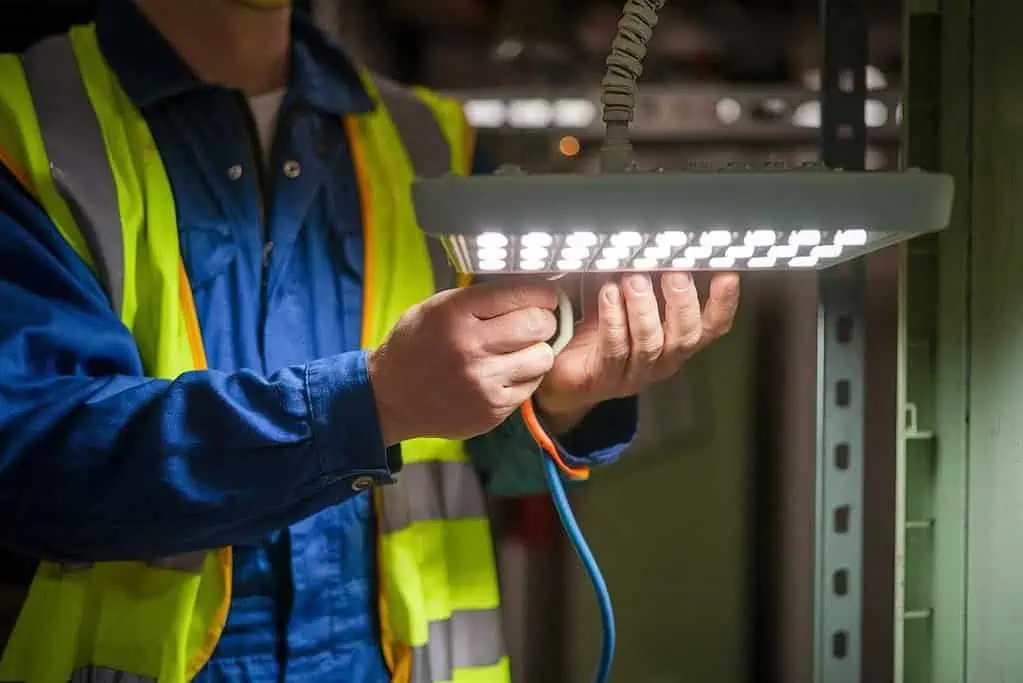
Protection Against Faulty Current Path
During a short circuit, grounding creates a low-resistance path to pass the faulty current to the ground. As a result, the faulty current doesn’t flow through the metal part or other components of the lights. Thus, grounding saves you from electrical shock when you touch the metal surface of the light.
Prevents Electric Shock
When any faulty current passes through the fixture, it energizes the metal part of the light. In such a situation, if you touch the light, you will face an electric shock. To prevent such a situation, grounding plays the hero role. It directs the faulty current towards the ground, preventing it from flowing through the metal part. This way, grounding prevents electrical shock.
Safety Against Fire Hazards
As the faulty current is directed away from the fixture due to grounding, it prevents electrical sparks. As a result, you can minimize fire hazardous risk by grounding LED lights.
Ensures Voltage Stability
Grounding provides a reference point for the electrical system to maintain a stable voltage. So, if there is any current leakage, grounding prevents voltage fluctuation by allowing the excess current to pass the ground. This way your light fixture saves from the damages caused due to voltage fluctuation.
Compliance with Electrical Standards
It is essential to ground the LED fixtures to adhere to electrical standard compliance. So, to ensure safety and follow the electrical standards, grounding LED fixtures is better.
Will An LED Light Fixture Work If Not Grounded?
The performance of LED light fixtures has nothing to do with grounding. LEDs are designed to operate at low power and have appropriate insulation to prevent electric shock. Therefore, grounding is not essential in most cases. And the LED light fixture still works ok without any grounding.
However, there is a safety risk of using ungrounded LED lights, especially if the light has a metal body and a poor heat dispersion system.
Risks of Not Grounding an LED Light Fixture
The greater risk of not grounding an LED light fixture is electric shock. If there is any faulty wiring or short circuit, an ungrounded light fixture can cause life-threatening shock.
Moreover, a lack of grounding also leads to voltage fluctuation, causing permanent damage to the fixture. There is a further risk of a fire breakout due to uncontrolled faulty current, voltage sparks, and surges.
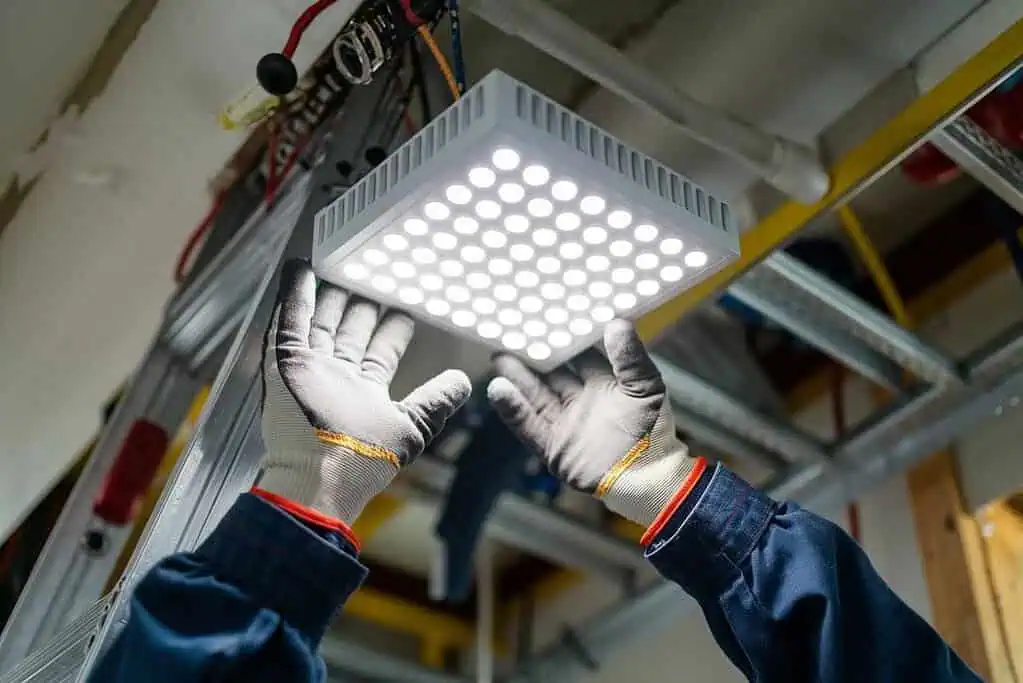
LED Grounding Regulations Standards and Codes
To ensure safety and reliable light installation, you must consider the following global standards and local safety codes to install your LED light fixtures:
| Regulation/Standard | Region | Key Requirements |
| National Electrical Code (NEC), or NFPA 70 | USA | • Covers grounding for electrical installations, including LED fixtures. • Sections 410-18 & 410-19 specify grounding in damp/wet areas. |
| International Electrotechnical Commission (IEC) | Europe | • Establishes safety guidelines for grounding in electrical systems. • Focuses on preventing shocks and fire hazards. |
| Local Codes & Regulations | Varies by region | • Offers grounding regulations considering environmental risks, like humidity, earthquakes, or outdoor lighting needs. |
How To Know If My Light Fixture Is Grounded?
Method 1: Visual Inspection
Physically inspect the light and look for the grounding wire. These wires mostly come in copper or green color. Besides, going through the manufacturer’s specifications, you will also find whether the light is grounded or not.
Method 2: Inspect Wiring
To inspect the wiring, turn off the light and remove the light from the wall/ceiling for wiring inspection. If you find the light is connected with copper or green wiring, it indicates the light is grounded.
However, if you see the LED light fixture mounted in the metal electrical box, look for a grounding wire connected to the box.
Method 3: Inspecting Through Circuit Tester
Switch off the light and check the voltage between the black and the copper/green wire using a circuit tester. If the tester shows zero voltage, it means the LED light is ground.
What To Do If The LED Light Fixture Is Not Grounded? – Solution
- Check the manufacturer’s specifications and go through the necessary grounding guidelines.
- Inspect the electrical wiring to look for grounding wires. If you find one connect it to the grounding wire of the LED light (in case the LED light is having grounding wire).
- If your LED light doesn’t have growing wire but the electrical box has it, add one to the light fixture, too.
- If your LED light comes with a grounding screw, connect the ground wire of the electrical box to it.
- Go through the local regulations to find out whether there is any specific grounding code essential for LED lights.
- If grounding is essential, consider replacing the old ungrounded fixture with a new one with a built-in grounding feature.
Wholesale LED Buying Guide: Understanding Proper Grounding
Know Your Codes: The ABCs of Electrical Safety
Research the NEC codes to get the necessary guidelines for grounding your LED lights. This also includes following the local regulations regarding electrical safety. For instance, if you are living in the US, follow the standards of the National Electrical Code (NEC). They cover all grounding practices and update their standards every three years. Again, for Canada, follow the codes by the Canadian Electrical Code (CEC) for the same purpose.
Partner with Electricians
Envolve certified electricians in your LED purchase to get proper grounding guidance. They will analyze the LED fixture type, application, installation area, and environment to suggest whether your light needs grounding or not.
Educate Your Customers
Instruct the customers to follow the manual to mark out the grounding requirements to ensure safety. All LED light fixtures don’t need grounding, for instance, the one with double insulation. So, tell the customer to go through the specifications and install the fixture accordingly.
Look for Certified Quality
Before purchasing LED light fixtures, check they are well-certified to ensure better quality. Some mandatory LED certifications to consider for electrical safety include- UL certification, ELT certification, etc.
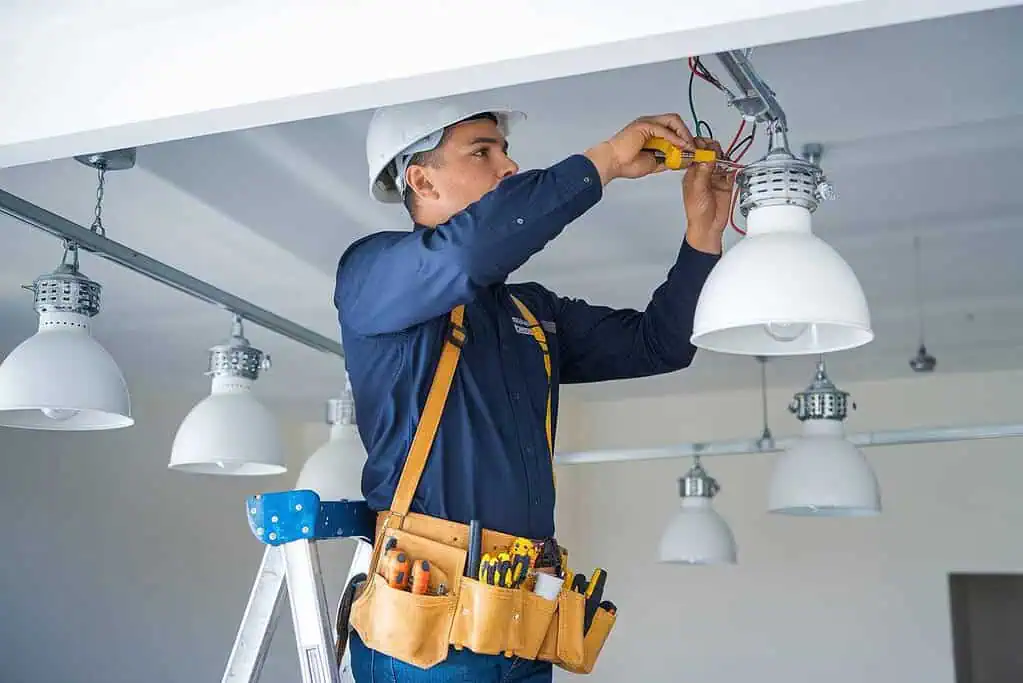
Step-by-Step Grounding Installation and Testing Guide
Step 1: Switch off the light to avoid any electrical shock.
Step 2: Look on the electrical box to locate the ground screw or grounding terminal.
Step 3: Attach the green or bare copper wire of the LED fixture to the ground screw of the electrical box. However, if your LED fixture has a metal casing, use a bonding jumper for grounding.
Step 4: Secure all the wire connections using wire nuts or grounding connectors.
Step 5: Test the grounding by placing a multimeter between the ground wire and the ground point. If the rating shows 0Ω or lower, the ground is properly connected.
Case Studies and Real-World Scenarios
Below, I have added three real-life cases to ensure electric safety by implementing grounding for LED light fixtures:
| Case Study | Location | Challenge | Solution |
| The Warehouse Upgrade | Texas | • Existing wiring lacked grounding • Posing safety risks | Ensured safe LED installation by retrofitting the ground wiring with the help of a certified electrician. |
| The Historic Hotel Renovation | New Orleans | • Ungrounded fixture • Safety risks | Replaced all the old lighting with modern built-in grounded LEDs. |
| The Outdoor Cafe Oasis | California | • Outdoor electrical outlets were not grounded | Installed GFCI outlets for outdoor LED lights to protect against electrical shocks. |
Future Trends and Smart Lighting Integration
In smart lighting, advanced sensors and control systems are involved. Grounding LED lights ensure the safety of these systems. Besides, the smart lighting integration makes the overall lighting installation expensive. If there is any short circuit or surge, the entire system can get damaged. Grounding LED, in this case, can save you from financial loss by preventing electric shock and light damage.
FAQs
For proper grounding, the rod should reach deep enough. According to the National Electric Code (NEC), it should be at least 8 feet (2.44 meters) deep. However, depending on the soil type and local regulations, the placement of the ground rod may vary.
As LED strip lights run in low voltage, it has minimal electric shock risk. This grounding is not mandatory for LED strip lights. However, for greater safety, you can use ground LED strip lights.
With more advanced LED technology, the LED retrofit is designed to upgrade traditional lighting, like incandescent or fluorescent. As LEDs run at low voltage, you can install them with the existing grounded wiring. So, a separate ground wiring is not necessary. However, you must follow the local guidance and manufacturer instructions to install the LED.
Outdoor lights come in direct contact with moisture, rain, thunder, and storms. So, to prevent electric shock issues, grounding is a must for outdoor lighting.
12-volt is a very low voltage with minimal tendency of electric shock. So, it’s ok not to ground 12-volt LED strip lights. However, if you want to ensure extended electrical safety, going for grounding is best.
Low voltage LED lights or the ones with double insulation don’t have an earth wire. They do not require earthing. However, high voltage LEDs or one with metal casings mostly comes with earth wire as they are more prone to electric shock and fire breakout.
You need to ground the negative terminal of the LED. it is the shorter one, known as the cathode.
To ensure the proper functioning of the LED trailer lights, grounding is crucial. Usually, a white ground wire is attached to the metal frame of the LED trailer. However, if you find the fixture to be a single-wire design, they are already self-grounded through the mounting hardware (e.g., screws or bolts).
The location of the light fixture grounding depends on the electric box you have in your hose. If it’s a metal electric box, the ground wire is connected to the ground screw inside the box. If it is a plastic box, the ground wire should be wired to the house’s ground wire (usually bare copper or green).
Yes, it’s absolutely ok, not to ground the light fixture as it doesn’t have any impact on light performance. However, for electrical safety and to adhere to local and standard regulations, it’s better to ground light fixtures.
Using a wire nut, you can easily ground the grounding wire of the LED ceiling light to that of the electric box.
The light will not glow if the wiring is not correct. However, it can also show flickering issues. Moreover, exposure to the wire can cause fire breakouts, electric shock, and life-threatening accidents.
Whether the ceiling light requires grounding or not depends on its design. If it’s a double-insulated light, grounding is not mandatory. Nevertheless, for extra layers of protection, it’s better to go for grounding.
Usually LED lights have double insulation and run under low voltage. This is why most LED fixtures have no ground wire.
The Bottom Line
Before installing LED lights, check whether it has built-in grounded features. In case your LED light lacks grounding, ground it following the manufacturer’s manual. However, before doing so, analyze whether your lighting really needs grounding or not. For instance, battery-powered or low-voltage LED lights like- LED strip lights don’t need grounding. So, in this case, you can skip grounding.
Nevertheless, for safe light installation, choose LEDYi LED strip lights. These are low-voltage fixtures, minimizing the risk of electrical shock. Moreover, our strip lights are UL and ELT-certified. So, if you want to skip the grounding hassles, our low-voltage strips are the go-to solution. Still, for extended safety, they also support grounding too.

